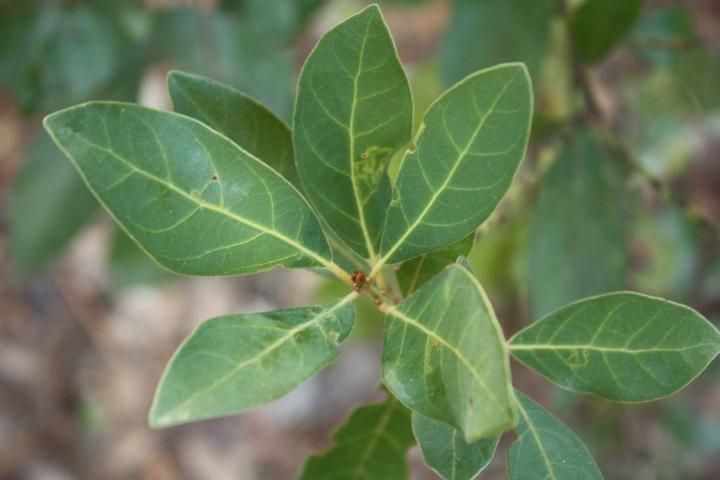Family
Lauraceae, laurel family.
Genus
Persea was first used by Theophrastus and Hippocrates when naming an Egyptian tree, the species of which is unknown to us today.
Species
The species name, palustris, means "of the swamp," indicating that this tree grows in wet areas.
Common Name
Swamp Bay, Swamp Red Bay
The word "bay" comes from the Latin word bacca, which refers to the fruit of this species.
Description
The taxonomy of this native evergreen tree has been somewhat controversial. Some lump swamp bay together with its close relative red bay (Persea borbonia), due to their similar appearance. However, the two species are easily distinguishable from one another and are treated as such in Florida. Swamp bay is found in hydric areas, such as swamps, wet flatwoods, and on the edges of canals and marshes, whereas red bay frequents mesic sites. The native range of swamp bay extends from Virginia south throughout peninsula Florida and west to Texas. It can grow up to 40 feet tall in partial shade or full sun. Leaves are simple and alternate and grow from 2 to 8 inches long. They are lanceolate or a slightly more elongated elliptical shape and have smooth or entire margins. The topside of the leaf is dark green and shiny, while the bottom side is a silvery white color with an orange tinge from pubescence that occurs primarily along the mid vein; distinguishing it from red bay, which lacks this rusty color and concentrated pubescence. Leaves have a distinct bay aroma when crushed. The bark ranges from red to grayish-brown and flower blooms are white and inconspicuous. Fruits are dark blue to black, 3/8 to 5/8 inch drupes, and appear on hairy reddish stalks in the summer.

Credit: CA Floristics, CC BY-NC-SA 2.0
Allergen
Like all bays, swamp bay is only slightly allergenic.
Applications
Medicinal
The root of swamp bay was used by the Creek Indians to discharge fluid from the bowels, and the Choctaws used a decoction of swamp bay to treat fevers by inducing perspiration.
Wildlife
Fruit from the tree serves as a good food source for birds and mammals, and the leaves are eaten by larvae of the swallowtail butterfly.
References
Austin, D. F. 2004. Florida ethnobotany. Boca Raton, FL: CRC Press.
Borror, D. J. 1988. Dictionary of root words and combining forms. Mountain View, CA: Mayfield Publishing Company.
Godfrey, R. K. 1988. Trees, shrubs, and woody vines of Northern Florida and adjacent Georgia and Alabama. Athens, GA: The University of Georgia Press.
Grimm, W. C. 2002. The illustrated book of trees. Mechanicsburg, PA: Stackpole Books.
Nelson, G. 1994. The trees of Florida: A reference and field guide. Sarasota, FL: Pineapple Press.
Ogren, T. L. 2000. Allergy-free gardening: The revolutionary guide to healthy landscaping. Berkeley, CA: Ten Speed Press.
USDA Natural Resources Conservation Service. (n.d.). PLANTS Database. Retrieved from http://plants.usda.gov/index.html
UF/IFAS Extension. 2008. Three bays for Florida yards. Retrieved from http://okeechobee.ifas.ufl.edu/News%20columns/3BayTrees.htm